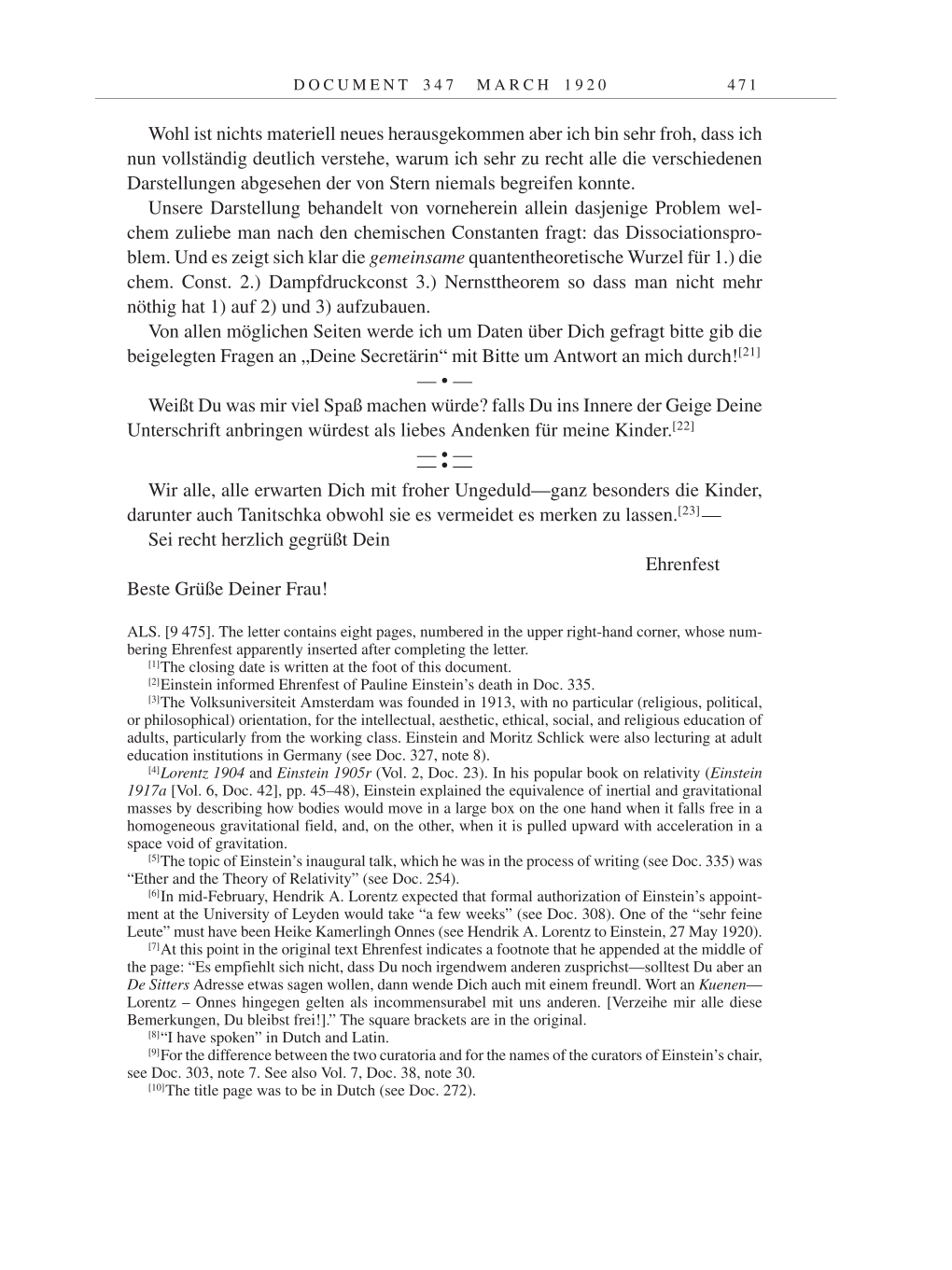D O C U M E N T 3 4 7 M A R C H 1 9 2 0 4 7 1
Wohl ist nichts materiell neues herausgekommen aber ich bin sehr froh, dass ich
nun vollständig deutlich verstehe, warum ich sehr zu recht alle die verschiedenen
Darstellungen abgesehen der von Stern niemals begreifen konnte.
Unsere Darstellung behandelt von vorneherein allein dasjenige Problem wel-
chem zuliebe man nach den chemischen Constanten fragt: das Dissociationspro-
blem. Und es zeigt sich klar die gemeinsame quantentheoretische Wurzel für 1.) die
chem. Const. 2.) Dampfdruckconst 3.) Nernsttheorem so dass man nicht mehr
nöthig hat 1) auf 2) und 3) aufzubauen.
Von allen möglichen Seiten werde ich um Daten über Dich gefragt bitte gib die
beigelegten Fragen an „Deine Secretärin“ mit Bitte um Antwort an mich
durch![21]
— • —
Weißt Du was mir viel Spaß machen würde? falls Du ins Innere der Geige Deine
Unterschrift anbringen würdest als liebes Andenken für meine
Kinder.[22]
— • —
— • —
Wir alle, alle erwarten Dich mit froher Ungeduld—ganz besonders die Kinder,
darunter auch Tanitschka obwohl sie es vermeidet es merken zu
lassen.[23]
—
Sei recht herzlich gegrüßt Dein
Ehrenfest
Beste Grüße Deiner Frau!
ALS. [9 475]. The letter contains eight pages, numbered in the upper right-hand corner, whose num-
bering Ehrenfest apparently inserted after completing the letter.
[1]The closing date is written at the foot of this document.
[2]Einstein informed Ehrenfest of Pauline Einstein’s death in Doc. 335.
[3]The Volksuniversiteit Amsterdam was founded in 1913, with no particular (religious, political,
or philosophical) orientation, for the intellectual, aesthetic, ethical, social, and religious education of
adults, particularly from the working class. Einstein and Moritz Schlick were also lecturing at adult
education institutions in Germany (see Doc. 327, note 8).
[4]Lorentz 1904 and Einstein 1905r (Vol. 2, Doc. 23). In his popular book on relativity (Einstein
1917a [Vol. 6, Doc. 42], pp. 45–48), Einstein explained the equivalence of inertial and gravitational
masses by describing how bodies would move in a large box on the one hand when it falls free in a
homogeneous gravitational field, and, on the other, when it is pulled upward with acceleration in a
space void of gravitation.
[5]The topic of Einstein’s inaugural talk, which he was in the process of writing (see Doc. 335) was
“Ether and the Theory of Relativity” (see Doc. 254).
[6]In mid-February, Hendrik A. Lorentz expected that formal authorization of Einstein’s appoint-
ment at the University of Leyden would take “a few weeks” (see Doc. 308). One of the “sehr feine
Leute” must have been Heike Kamerlingh Onnes (see Hendrik A. Lorentz to Einstein, 27 May 1920).
[7]At this point in the original text Ehrenfest indicates a footnote that he appended at the middle of
the page: “Es empfiehlt sich nicht, dass Du noch irgendwem anderen zusprichst—solltest Du aber an
De Sitters Adresse etwas sagen wollen, dann wende Dich auch mit einem freundl. Wort an Kuenen—
Lorentz – Onnes hingegen gelten als incommensurabel mit uns anderen. [Verzeihe mir alle diese
Bemerkungen, Du bleibst frei!].” The square brackets are in the original.
[8]“I have spoken” in Dutch and Latin.
[9]For the difference between the two curatoria and for the names of the curators of Einstein’s chair,
see Doc. 303, note 7. See also Vol. 7, Doc. 38, note 30.
[10]The title page was to be in Dutch (see Doc. 272).
